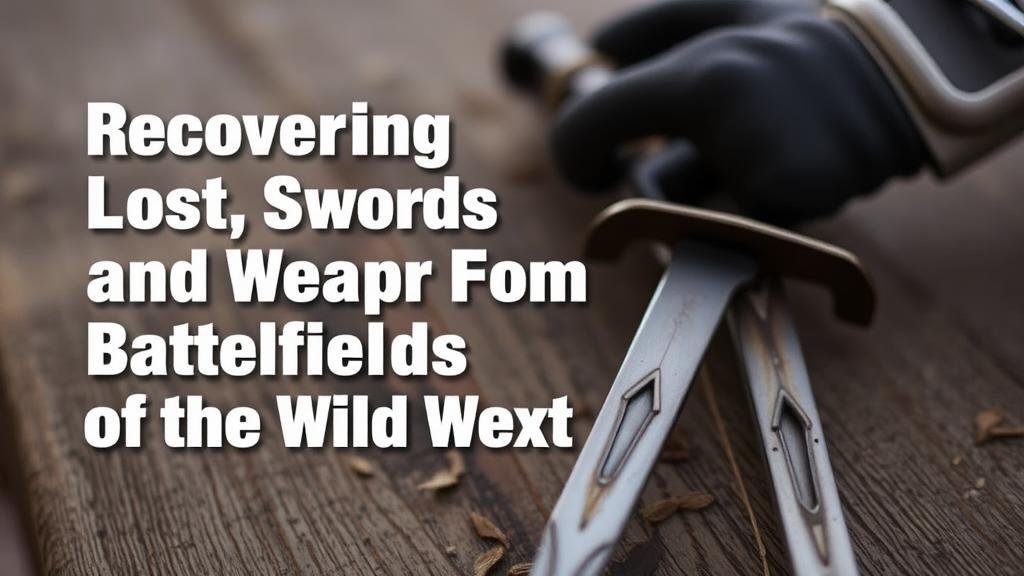Recovering Lost Swords and Weapons From Battlefields of the Wild West
Recovering Lost Swords and Weapons From Battlefields of the Wild West
The Wild West, known for its lawlessness and tumultuous battles, is also a treasure trove for historians and archaeologists interested in recovering lost swords and weapons. This article explores the methods employed in the recovery of these artifacts, discusses their historical significance, and highlights notable examples of successful recoveries.
The Historical Context of Weaponry in the Wild West
The Wild West era, spanning from the late 19th century to the early 20th century, was characterized by numerous conflicts, including clashes between Native Americans, outlaws, and settlers. Weapons such as revolvers, rifles, and swords were not merely tools of war; they signified authority and power during a time of significant social and political upheaval.
In particular, swords played a crucial role in close-quarter combat, particularly before revolvers became prevalent. significance of these weapons is underscored by their association with famous figures such as Wild Bill Hickok, whose legendary duels helped shape the mythology of the West.
Techniques for Recovering Artifacts
Recovering lost weapons from battlefields involves a combination of historical research, excavation techniques, and contemporary technology. The following methods are frequently employed:
- Historical Research: Before any physical recovery, researchers dive into historical records, diaries, and local lore to pinpoint potential battlefield sites.
- Metal Detection: Using advanced metal detectors, archaeologists can locate buried metallic artifacts with precision. These detectors vary in sensitivity and range, allowing for the identification of different types of metals.
- Excavation Techniques: Once a site is identified, meticulous excavation is essential. Stratigraphic techniques are utilized to ensure the context of the findings is preserved, which aids in historical interpretation.
In many cases, interdisciplinary teams–including historians, archaeologists, and even local residents–join forces to enhance the research and excavation processes.
Case Studies of Successful Recoveries
Several notable recoveries of lost swords and weapons from Wild West battlefields illustrate the importance of these artifacts in understanding American history:
- The 1865 Battle of Crow Agency: In 2012, archaeologists uncovered several Civil War-era weapons, including swords and rifles, near the site of the battle. These artifacts provided insights into the logistics and weaponry of the conflict, enriching the historical narrative surrounding the event.
- Gatling Gun Recovery in New Mexico: In 1995, an old Gatling gun was recovered from a forgotten grave site in New Mexico, believed to be from the notorious skirmish at Kearny Pass. This recovery not only showcased the technology of its time but also highlighted the evolving nature of warfare strategies.
Legal and Ethical Considerations
Recovering artifacts from battlefields is not without its challenges. Legal and ethical considerations must be addressed, as many sites are protected under archaeological conservation laws. Artifacts often belong to cultural heritage or indigenous tribes, necessitating thoughtful collaboration with local communities.
Respecting the context of the battlefield while ensuring that the recovery process adheres to legal frameworks is crucial. In some cases, it may even be necessary to avoid recovery altogether if it risks desecrating a site of historical significance.
The Impact of Technological Advances
Recent advancements in technology have significantly improved the ability to recover lost swords and weapons. Innovations such as ground-penetrating radar and 3D mapping have opened new frontiers in archaeology, allowing for non-invasive exploration of potential sites. These techniques not only facilitate targeted excavations but also minimize environmental impact, preserving the integrity of the battlefield.
Actionable Takeaways
For those interested in participating in recovery efforts or pursuing a career in this field, consider the following steps:
- Engage in historical research to understand the significance of various battlefields.
- Learn metal detecting techniques and pursue training in archaeological excavation methods.
- Familiarize yourself with legal frameworks regarding artifact recovery in your area.
- Network with local historians, archaeologists, and preservation societies to find opportunities for involvement.
As the Wild West continues to capture the imagination, the recovery of swords and weapons not only preserves history but also contributes to our understanding of a transformative period in the United States. By employing appropriate methods and respecting legal considerations, we can ensure that these artifacts continue to inform and educate future generations.



